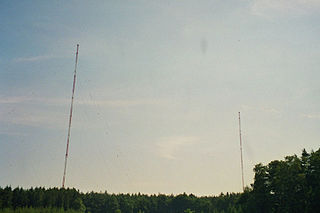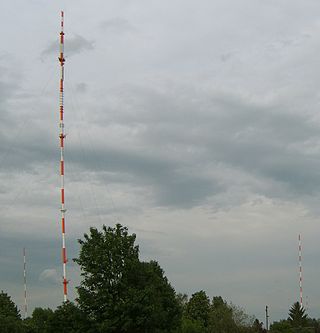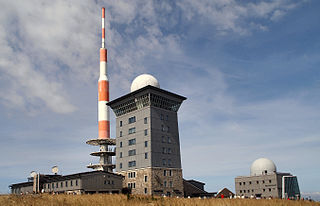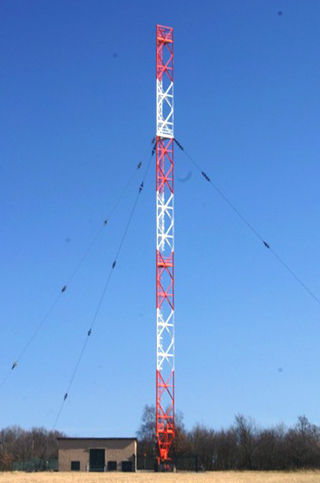
The Sender Donebach was a 500-kilowatt long wave radio transmitter operating on 153 kHz and transmitting the program of German public broadcaster Deutschlandfunk. The facility, which was the property of Media Broadcast, was built between 1965 and 1967 on a former airfield, and entered service on March 10, 1967.

The Longwave transmitter Europe 1 was the oldest privately owned radio station in Germany, situated between Felsberg and Berus/Saar, Germany. It transmitted on 183 kHz with a power of 2,000 kilowatts a French speaking programme, Europe 1 toward France. It was the highest power radio broadcasting transmitter in Germany. Longwave transmissions stopped on 31 December 2019.

The Roumoules transmitter is the main broadcasting facility for longwave and mediumwave broadcasting of Radio Monte Carlo near Roumoules, France and is owned by Monaco Media Diffusion. The 1000 and 2000kW transmitters installed are among the most powerful in the world and can be received well at nighttime throughout Europe.

The Mühlacker Broadcasting Transmission Facility is a radio transmission facility near Mühlacker, Germany, first put into service on November 21, 1930. It uses two guyed steel tube masts as aerials and one guyed steel framework mast, which are insulated against ground. It has two transmission aerials for shortwave and one free standing steel framework tower for directional radio services. The shortwave transmitter was shut off on October 19, 2004. The medium wave transmitter was switched off in January 2012.

The AM transmitter in Burg, near Magdeburg, Germany, is a huge facility for longwave and mediumwave broadcasting. Its most dominant constructions are a 324-metre guyed radio mast and two 210 metre guyed steel tube masts.

The Langenberg transmission tower is a broadcasting station for analog FM Radio and Digital-TV signals. It is located in Langenberg, Velbert, Germany and owned and operated by Westdeutscher Rundfunk, WDR.

The Transmitter Hamburg-Billstedt is a broadcasting facility in Hamburg-Billstedt, established in 1934. It is owned and operated by the Norddeutscher Rundfunk public broadcasting service, but open to competitors, too.

The Transmitter Ismaning was a large radio transmitting station near Ismaning, Bavaria, Germany. It was inaugurated in 1932. From 1932 to 1934 this transmitter used a T-antenna as transmitting antenna, which was spun between two 115-metre-high free-standing wooden lattice towers, which were 240 metres apart. As this antenna had an unfavourable vertical radiation pattern, which produced much skywave resulting in a too small fading-free reception area at night, in 1934 a new antenna was installed. Therefore, one of the towers was dismantled and rebuilt on a 39-metre-high (128 ft) wooden lattice base. While this work took place, an L-Antenna was used, which was spun between the other tower and a small auxiliary wooden tower. It became defunct in 1977 and was destroyed in 1983.

The Wachenbrunn transmitter was a large broadcasting facility for medium wave in Wachenbrunn near Themar, Thuringia, Germany, established in the 1950s. Until 1993 the main transmitter of this facility, the medium wave transmitter for 882 kHz was run with 250 kilowatts. In that year the transmission power of this transmitter, which was formerly used for transmitting the "Voice of DDR" and since the beginning of the 1990s for "MDR info" was reduced to 20 kilowatts.

The Rheinsender is an FM radio transmission site for the German Südwestrundfunk regional public broadcasting system. The Rheinsender is located near Wolfsheim, southwest of Mainz.

The Heusweiler transmitter was a facility for medium wave broadcasting north of Heusweiler, Germany. It originally went into service on 23 December 1935. On 19 June 1946 transmitter Heusweiler went in service again.

The Brocken Transmitter is a facility for FM- and TV-transmitters on the Brocken, the highest mountain in Northern Germany.

The Sottens Transmitter is the nationwide transmitter for French-speaking Switzerland. The transmitter is located at Sottens, Canton of Vaud, Switzerland. It is run on 765 kHz with a power of 600 kilowatts and is easily receivable during the night throughout the whole of Europe. Since 1989 the aerial used has been a centre-fed dipole fixed on the outside of a 188-metre-high grounded freestanding steel framework tower. Before 1989 a 190-metre high self-radiating, free standing steel framework tower was used as a transmission aerial. The Sottens transmitter most recently broadcast the Option Musique radio programme from Radio Suisse Romande, up until 5 December 2010.

The Żórawina radio transmitter is a facility for FM transmission at Żórawina, south of Wrocław. It was established in 1932 as "Reichssender Breslau" and used as an antenna tower. Originally it was a 140-metre-tall free-standing lattice tower built of wood, on which a wire antenna was hung up. On the top of the tower there was an octagonal ring of bronze with a diameter of 10.6 metres for electrical lengthening of the antenna.
The Zeven DECCA-transmitter was a transmitting facility for DECCA transmission at Zeven, Germany. It used a 93 metre tall guyed mast antenna, which is insulated against ground. As backup antenna, a 46-meter mast radiator also insulated against ground was in its proximity.
Goliath transmitter was a very low frequency (VLF) transmitter for communicating with submarines, built by Nazi Germany's Kriegsmarine navy near Kalbe an der Milde in Saxony-Anhalt, Germany, which was in service from 1943 to 1945. It was capable of transmission power of between 100 and 1000 kW and was the most powerful transmitter of its time.

The Wiederau transmitter is the oldest broadcasting facility in Saxony. It is located near Wiederau, a village which is part of the municipality of Pegau, and is used for medium-wave, FM and Television broadcasting.
Golm transmitter or Sender Golm was a medium wave broadcasting facility on the area of a former Reichsarbeitsdienst officer candidate school at Kuhforter Damm in Golm near Potsdam. It entered service in 1948 as the central broadcast transmitter for Brandenburg state. Until 1979 it used a wooden lattice tower of 98 m (322 ft) height with a horizontal wooden cross on its top as its antenna support. The ends of the beams of this cross were connected with wires. From the centre of each of these horizontal wires, a vertical wire was run down to the antenna tuner which was located in a building under the feet of the tower construction. The antenna of Golm transmitter consisted therefore of 4 T-antennas connected in parallel, forming an omnidirectional antenna with a natural wavelength of 528 m. The transmitter was built from second-hand parts obtained by dismantling a site in Reichenbach, Upper Lusatia. Test transmissions were undertaken on 16 April 1948, and from 1 May 1948 the facility operated on 564 kHz.

Marnach transmitter was a broadcasting facility of RTL near Marnach in the commune of Clervaux, in northern Luxembourg. The Marnach transmitter was built in 1955 for improving the transmission of the English-speaking program on 1439 kHz, which was transmitted from 1951 with an omnidirectional antenna from Junglinster, to the British Isles and for a better transmission on this frequency to Germany at daytime. Therefore, it was given a directional antenna with a switchable directional characteristic pointing north-northeast towards the Rhine-Ruhr area, Germany's most populated area, and west-northwest in the direction of the UK. This antenna was implemented in form of a directional antenna consisting of three ground-fed 105-metre-tall (350 ft) guyed mast antennas arranged in the form of an isosceles triangle with a 90-degree angle. As transmitters, two 100 kW units switched in parallel were used when it went in service in December 1955.
Berlin-Köpenick transmitter was a transmission facility for broadcasting on medium wave, short wave, and VHF in Berlin-Köpenick, Germany, near the suburb of Uhlenhorst, after which it was occasionally named.
















